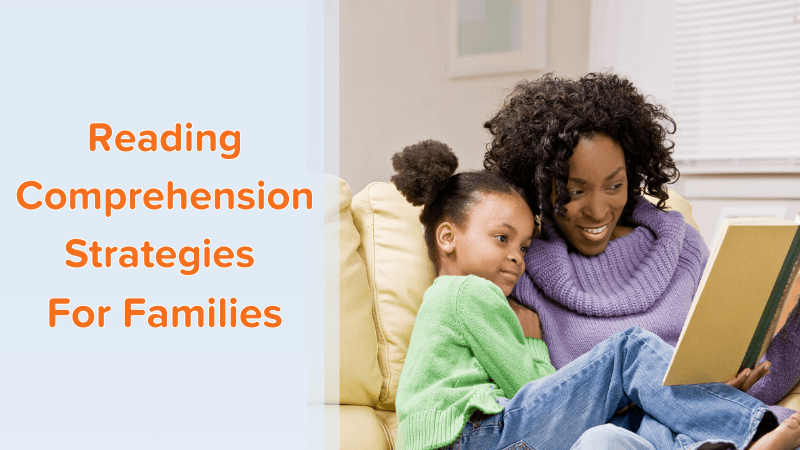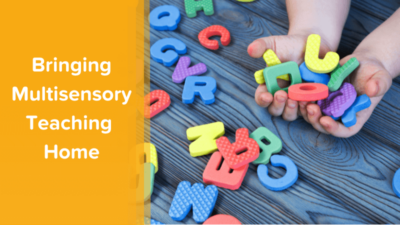By contributing author Curran Mahowald, M.A. Cognitive Science in Education
Literacy programs aligned to the science of reading include focus areas such as vocabulary development, phonological awareness, phonics, and fluency. This article highlights how educators can help families support students to build skills in one of those areas, reading comprehension.
’Twas brillig, and the slithy toves
Did gyre and gimble in the wabe:
All mimsy were the borogoves,
And the mome raths outgrabe.
Can you read this excerpt of poetry? If you’re like most people who encounter Lewis Carroll’s Jabberwocky, you have little trouble reading it out loud, but you can’t form a mental picture of what’s being described. Even Alice, the character who reads the poem as it appears in Through the Looking Glass (1871), says “It seems very pretty…but it’s rather hard to understand.”
Reading comprehension is the difference between true understanding and pronounceable nonsense.
Achieving reading comprehension feels effortless to experienced readers in most cases (with the exception of whimsical 19th-century poetry), but it’s actually a complex, active process of constructing meaning.
Reading comprehension relies on a variety of skills and knowledge. A successful reading process involves decoding words, accessing the meaning of those words, and constructing the meaning of sentences and the story as a whole.

Parents are well-positioned to build these early reading skills of language and reading comprehension on a daily basis. Almost every interaction a parent has with a child has the potential to be a language- and story-rich interaction and build an array of skills that children need to become proficient readers. Supporting language and literacy does not take lots of resources, and it can be lots of fun with the practice activity ideas that we’ll share.
First, we’ll explain what parents and caregivers can do in the years before school to foster the foundational skills that lead to essential reading skills later on.
Next, we’ll cover six effective reading comprehension strategies that all levels of readers can use. For each strategy, we’ll also share a sample family-facing message from the ParentPowered family engagement program. These messages provide simple and fun tips on how parents can help their children learn comprehension strategies and become proficient readers.

Supporting reading readiness
Build oral language skills
Children begin building foundational skills that support reading comprehension from birth. As adults who read text nearly as effortlessly as we listen to spoken language, it’s easy to forget that oral language comprehension precedes reading comprehension. That is, most effective readers were first effective listeners and speakers, at least mastering the basic phonology skills of at least one language. The written word is actually an artificial format to capture the natural phenomenon of language.
Because textual language is derivative of spoken language, the ability to comprehend what we’re reading relies not only on decoding the words and structures we see but also knowing what these mean from our early experiences with oral language. Not all children get the same amount or richness of exposure to oral language in the infant and toddler years (Hart & Risley, 1995), and this has consequences for reading and general cognitive abilities later on.
Here are some ways parents of young children can leverage everyday moments to build language skills on an ongoing basis, long before they begin the reading process.
Ask questions and have conversations
Asking questions, especially open-ended ones, gives children a chance to practice understanding and producing the forms and structures of language. When they construct answers to questions, they are constructing their knowledge about language. Having question-answer exchanges also teaches children about pragmatics, or the social conventions of language in practice.

FACT: The more children talk, the more ready they are to read and write. Children get excited to talk about their favorite things and experiences.
TIP: During playtime, ask your child to tell you about the toy they’re playing with. Ask, “What are you playing with? What does it do? That’s so cool!”
GROWTH: Keep talking. You’re preparing 4K! Let your child choose an activity. Ask, “What do you want to play today? How do we play?” Have fun playing together!
Narrating Actions
The more language children hear, the better! And when they hear the word “spoon” while a parent is using the spoon, it’s easier for them to connect the form to the meaning of the word. Narrating actions is a simple way to use language in context for the benefit of your child.
FACT: When you describe the things that you see and do, you’re helping your baby develop early vocabulary and language skills. Describe things early and often!
TIP: As you prepare a meal, describe your actions. Say, “I’m stirring the soup. The spoon goes around and around in the bowl. Now I’m adding pepper!”
GROWTH: Keep describing what you see and do. Try describing your baby’s movements during tummy time. Say, “You’re lifting your head to look at me. Hi baby!”
Build vocabulary
Reading research indicates that vocabulary development is one of the foundational reading skills necessary for success. Unlocking word meaning is one of the basic reading comprehension skills that allow us to derive meaning from the text as a whole. Parents are well-positioned to build their children’s vocabulary by using a wide variety of words when they talk to them.

FACT: Words open up a world of learning. They help children learn about the world around them. They also help kids and communicate with friends and adults.
TIP: At bedtime, introduce new words by saying good night to things in your child’s room. Try, “Good night pillow, good night blanket, good night light bulb.”
GROWTH: Keep naming objects to prepare 4K! Add descriptive words as you say a silly good morning to things in your child’s room: “Good morning SHAGGY carpet!”
Build print awareness and love of books
An important part of the literacy process is learning how books work and discovering the joy that both books and stories can bring us. Here are some practice activity ideas for parents who want to teach their children key ideas they’ll need for future independent reading.
Make book-reading a participatory activity
You don’t need story maps or graphic organizers to engage in active reading. Whether the child is eight years old or in eigth grade, you can’t go wrong by asking them questions about the story.
FACT: The more children are involved in a book the more they’ll understand. Talking about what’s happening and what might happen next really gets kids involved!
TIP: Stop at the end of each page when reading a familiar bedtime story together. Ask, “What do you think will happen next? Why?” Try the same with a new book.
GROWTH: Keep guessing what comes next! You’re preparing your child 4K. Read a rhyming book together. Leave off the last rhyme. Can your child guess what comes next?
Use illustrations
The illustrations in a picture book are a helpful resource for understanding the story. And when caregivers draw the child’s attention to the illustrations, they’re showing her that just like in spoken language, what you hear connects to what you see.
FACT: Looking closely at illustrations helps children understand books. You can build this skill by looking at the pictures before you read the words.
TIP: At bedtime, look at the cover of a book with your child and ask them to describe what they see. Then ask, “What do you think the story will be about?”
GROWTH: Keep looking at pictures to prepare your child 4K. Turn to the first illustration and ask, “What do think the characters are thinking? Feeling? Doing?”
Bring the story to life
Acting out fun, action-packed stories is not only a fun exercise for children; it also encourages making an inference from context clues.
FACT: Acting out stories is a wonderful way to bring books to life. It also helps kids deepen their understanding of the story and build key literacy skills.
TIP: After you finish a book, act out your favorite part of the story. You and your child can choose to be your favorite characters and do what they did!
GROWTH: Keep acting out books. You’re getting ready 4K! Now try acting out the whole story. Take turns turning the pages and acting out what you see!
Practice basic book handling
Part of what we know when we know how to read is the way in which text is organized. When parents read to their children and use some basic teaching strategies, children pick up on this important knowledge that most adults take for granted.

FACT: New readers learn we read from left to right, top to bottom, and front to back. Your child learns this by following along as you read together.
TIP: Snuggle up during reading time. Place your child’s hand in yours and point together at each word as you read it. Can they point to words without your help?
GROWTH: Keep exploring books together! Now ask your child to hold the book, and point to where you start reading. Ask them to help by turning pages.

Six key reading comprehension strategies
Now that we’ve discussed the early language and literacy skills that allow children to become readers, we can talk about the strategies readers use to make meaning of what they read. These comprehension strategies work for any kind of text and any age student. Even experienced adult readers use these strategies, often without realizing it! But there’s a first time for everything, and young readers can benefit from explicit instruction in these strategies.
1. Activating background knowledge
Successful readers make connections between ideas in the text and their own prior knowledge and personal experiences. Activating background knowledge helps all students with comprehension, and it’s especially important for students who are English learners. When a student who is learning English encounters a word they don’t know, there are two different possibilities for what’s happening.
Let’s say the student is struggling to comprehend an expository text including the word “sleet.” The student may have seen freezing rain many times and just not know the word for this concept in English. Alternatively, the student may come from a country where this type of weather never happens. In either case, activating background knowledge is a great cognitive strategy.

In the first case, a teacher or parent can use the word for “sleet” in the home language to activate the student’s background knowledge of this phenomenon. English learner students often just need help mapping existing key concepts to the new words they encounter in English. Just because they don’t know the words for it in English doesn’t mean they don’t have conceptual knowledge about a topic.
In the second case, the student could benefit from a quick explanation of sleet, preferably with a video or other visual aid. This direct instruction promotes equity in education by ensuring that individual students have what they need to access the learning.
Sometimes, just asking students questions that lead them to remember familiar stories or their own experience is an effective intervention strategy.
FACT: Understanding others’ emotions is a big first step in learning how to make and play with friends. You can help your child notice how others are feeling.
TIP: As you read bedtime books, pause when a character is feeling sad or scared. Ask, “How are they feeling? How can you tell? Have you ever felt that way?”
GROWTH: Keep talking about how others feel! Now when you read about a character who feels sad or scared, ask: “What would you do to help them feel better?”
2. Predicting
Predicting is powerful! In this reading comprehension strategy, students use what they have understood from the story so far to guess what might happen next. When students anticipate the future of a story, they lean on prior knowledge, contextual clues, and understanding of story elements and genre. These informed guesses can be about the plot, character development, and outcomes.
Predicting encourages students to make inferences and activate background knowledge. For example, if I’m reading E.B. White’s Charlotte’s Web, once I learn that Charlotte has woven a special message in her web to try to save Wilbur, I might predict that this will catch people’s attention and make them think differently about farm animals.
Another way predicting helps with reading comprehension is by giving the reader a more personal stake in what happens in the story. When you have an expectation for how something will go, you’re more eager to find out the result. It’s fun to find out whether your prediction is correct! I’m not likely to put down Charlotte’s Web until I find out whether Homer Zuckerman changes his mind about Wilber’s fate based on the extraordinary workings of the animals in the barn.
FACT: In school, kids begin reading longer books with more details. Making sure they understand what they read is key to helping them thrive.
TIP: At bedtime, check in with your child. Ask, “What are you reading?” Then try, “Tell me about the story so far.” Ask, “What do you think will happen next?”
GROWTH: Keep checking for understanding. Now ask your child to read a page or two of their book to you. Ask, “What did you find interesting about that part?”
3. Monitoring comprehension
Have you ever finished a page of a book and realized you have no idea what you just read? You probably decided to re-read the paragraph until you processed and understood it. That process of noticing and taking action is called comprehension monitoring. It’s a super important strategy for understanding what you read.
Because comprehension monitoring involves assessing and evaluating your own understanding, it is an example of metacognitive skills (thinking about your own thinking).
Skilled readers use these metacognitive skills all the time. They check in with themselves every couple of sentences with questions like “Does this make sense? Am I following the main idea? Do I need to reread or seek clarification?” Experienced readers also often use self-explaining, which is like making a mental note in their own words about what’s happening and why.

By engaging in comprehension monitoring, readers take an active role in their own learning process, becoming aware of any potential gaps or areas of confusion. Parents can foster this skill by modeling it themselves. They can think aloud while reading and ask students questions that encourage self-reflection and self-assessment.
Readers who use comprehension monitoring are better able to follow a story and navigate complex texts with confidence.
FACT: At this age, kids start to really notice ways they learn best and strategies that work for them. Talking about these discoveries builds study skills.
TIP: After your child finishes an assignment, ask about it. Try, “What went well? What are some of the strategies you used to do this or figure this out? Did you make an outline? Take notes?”
GROWTH: Keep asking about your child’s assignments. After finding out what went well, try, “Was anything challenging? Anything you’d do differently next time?”
4. Asking questions
In school, kids are always being asked questions about what they’re reading. At home, caregivers can turn the tables and invite kids to come up with their own questions.
One way families can support this strategy at home is to model the process of asking thoughtful questions about the book. This creates an open and inquisitive atmosphere around book-reading. It also shows that reading is an active conversation with the author and the ideas.
Types of questions adults can model and children can ask about the text:
- Clarifying question—e.g. What is a runt?
- Connecting question—e.g. What do Charlotte and Fern Arable have in common?
- Inferential question—e.g. Why does Fern want her aunt and uncle to buy Wilbur?
A little curiosity goes a long way in promoting reading comprehension, especially with scaffolding from a grown-up reading partner.
FACT: Asking your child WHO, WHAT, WHY, and WHERE questions during story time helps them understand books and become a better writer, too.
TIP: As you read a story, ask questions. Point to a picture and say, “WHO is this? WHAT are they doing? WHY are they doing it? WHAT will happen next?”
GROWTH: Now after a story, ask a HOW question to get your child really thinking! Say, “HOW would this story be different if it were in outer space?”

5. Retelling
When children retell a story, they process what happened and put it in their own words. Parents can encourage this strategy by asking their child to retell the main events, characters, and key details of the story.
By asking open-ended questions such as “What happened in the story?” or “Who were the main characters?” adults help children organize their knowledge about the story.
If the child is struggling to remember what happened, no problem! Just go back into the text to find the answers. Looking at the pictures helps too!
Parents can also take turns retelling parts of the story themselves. Modeling the strategy shows kids what to do.
FACT: In school, kids retell stories. They write about them, talk about them, and act them out. When kids retell stories, it shows they understand stories.
TIP: When your child gets home from school ask, “What book did your teacher read today? What happened in the story? What was your favorite part?”
GROWTH: Keep retelling stories! Now retell a story that YOU loved as a child. Make sure to include lots of details about the setting and characters.
6. Embracing storytelling in all its forms
When it comes to childhood learning, all roads lead to play, and reading is no exception. Acting out the story with character voices is an awesome reading comprehension strategy that brings the book to life and makes reading a blast.
Choosing a voice for each character requires the reader to understand key character traits and plot points. Is this character old or young? Confident or nervous? An evil genius or a helping hero? This strategy leverages the power of creativity and the joy of play to foster comprehension of a story.

FACT: When you give book characters different voices, you help your child learn that each character is different. This helps your child understand stories.
TIP: When reading a book to your child, give each character a different voice. Try high and low voices. Each time the characters speak, use the special voices.
GROWTH: Keep giving characters different voices. Your child can try as they read to you! Ask your child to show you what each character sounds like.
Reading comprehension helps students thrive
Reading comprehension is essential for success in school and life. Parents and educators both want kids to become skilled readers who can inform and entertain themselves with a wide range of texts. Fortunately, there’s a lot parents can do to build the foundational skills for reading and support comprehension on an ongoing basis as children advance through increasingly complex texts.
For experienced readers, comprehension is the jumping off point for an even more exciting part of the literacy process — exercising critical thinking skills. The level of understanding that is required to analyze a text critically may be higher than the level needed to answer multiple choice questions. But underneath all levels of readers are the foundational skills of comprehension that parents can help develop one simple activity, one conversation, one story at a time.

About the author
Curran Mahowald is a former high school language teacher turned education research advocate. In addition to having worked at ParentPowered, she has also designed parent-facing informational materials at Oakland Unified School District and currently works on improving national research-to-practice infrastructure at the Annenberg Institute for School Reform at Brown University. Curran holds an M.A. in Cognitive Science in Education from Teachers College, Columbia University and B.A.s in Linguistics and French from the University of Southern California.





